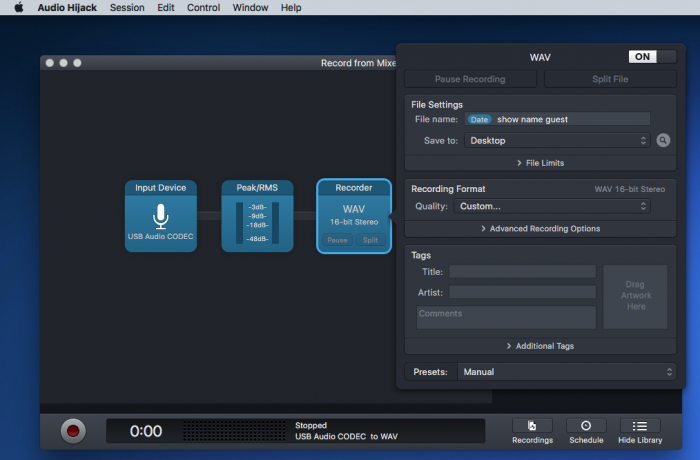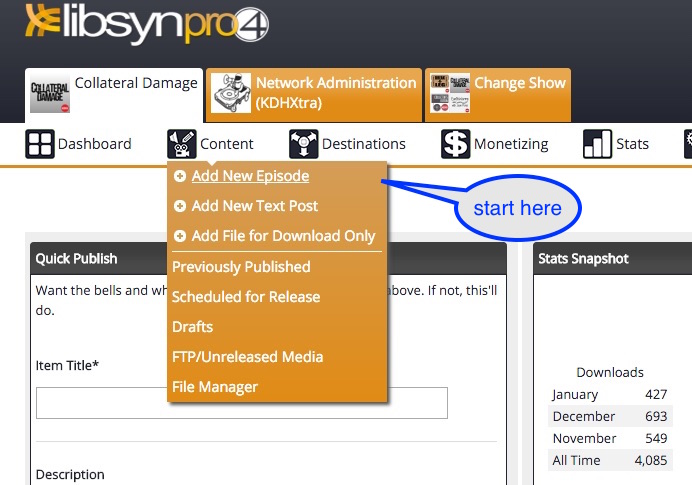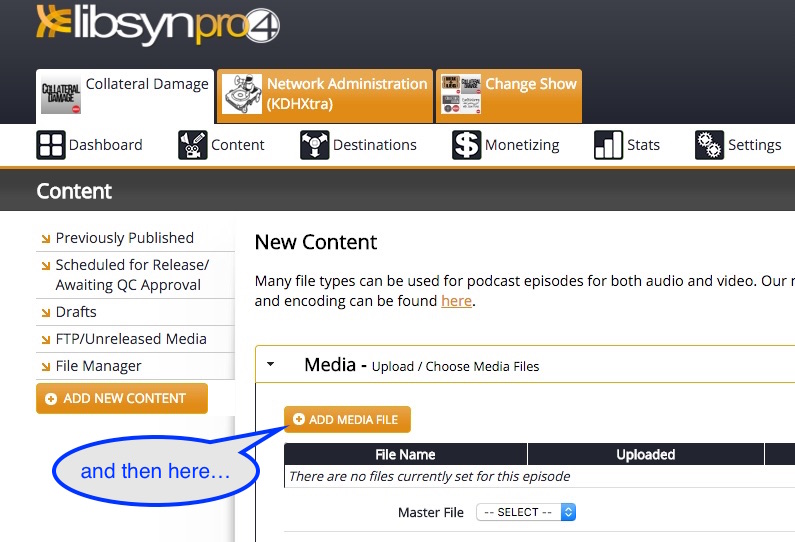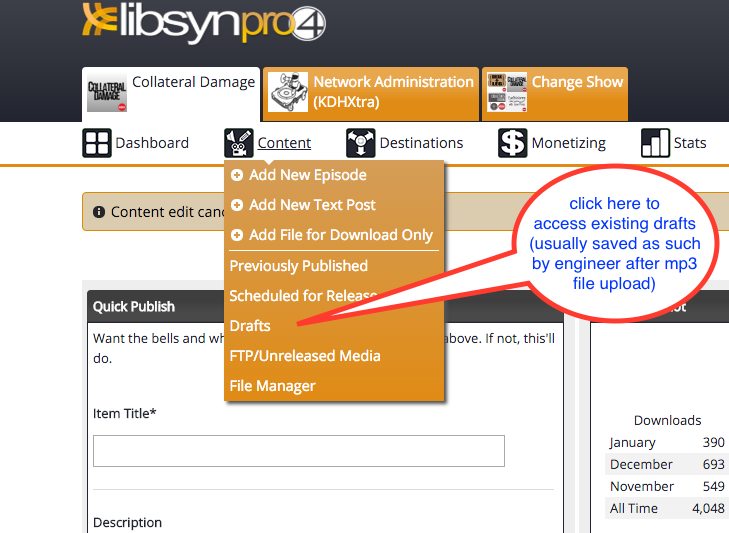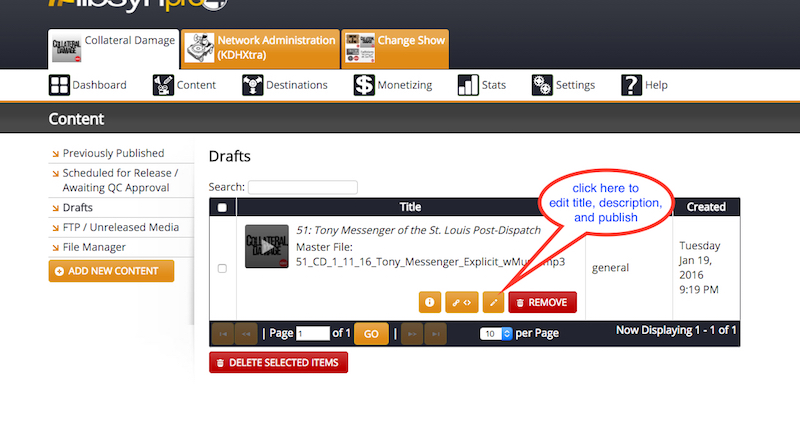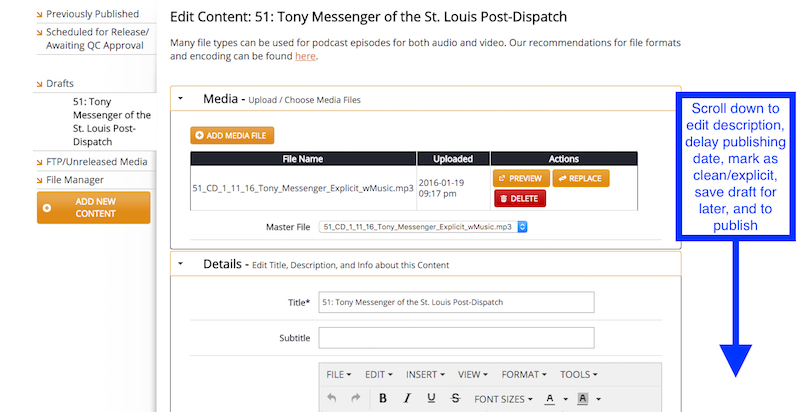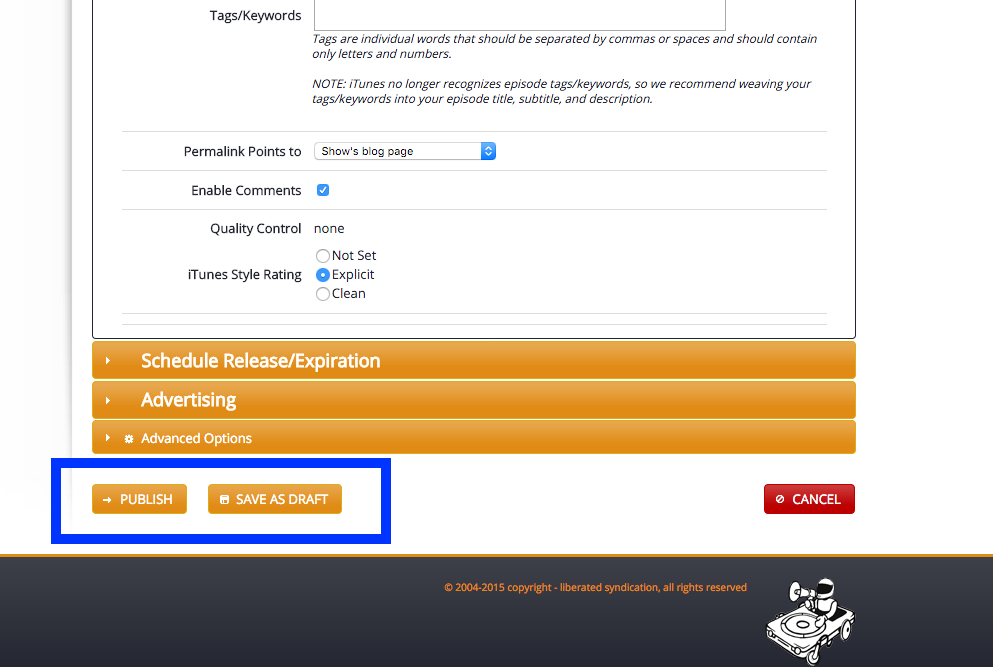Difference between revisions of "KDHX Podcast Guide"
(→Audio Specs) |
(→Audio Specs) |
||
| Line 85: | Line 85: | ||
=== Audio Specs === | === Audio Specs === | ||
| − | [[File:hijack-recordsetting.png]] | + | [[File:hijack-recordsetting.png|700px]] |
*record and edit as AIFF or WAV | *record and edit as AIFF or WAV | ||
Revision as of 20:05, 28 August 2017
Contents
Introduction to Podcasting with KDHX
Podcasting has become one of the best ways to build audience for in-depth informative types of programming, and is THE vehicle for getting content to the listeners who want it most. It is a highly successful method of building community around a topic, and providing richer and more engaging information to your audience.
Something to consider is how you as host are a big part of what the listener is subscribing* to. Your personality, expertise, connections to the content, and ability to inform are key to the ability of the program to build audience. Some of the tips and guidelines below reference how you'll handle this best on the platform.
(*subscriptions to KDHX podcasts are FREE, by the way, but encouraging your audience to support KDHX and converting listeners to supporting donors is still an important facet of producing your program)
General Guidelines for Programs on podcasts.kdhx.org
AUDIENCE FOCUS TIPS
- Aid your listeners by providing text for the show titling and show notes prior to recording each episode in a new LibSyn draft. Writing this in advance is good practice, will assist your recording technician, and will be a part of your general preparation for the introduction, interview and, and closing
- title: should be AP Style, 5-8 words (max 80 characters) - short, catchy, snazzy. Ideally as a headline that includes guest, and topic
- description: should contain a program synopsis with searchable keywords, and all of the information that listeners may want to dig deeper into the topic - include links, images, and anything else that will serve to complement the podcast
- Introduce self as host at beginning (and end) of podcast
- Introduce topic and guest with credentials: "The focus of this episode of the program is [topic]. My guest is [guest name], [credentials, and/or position at organization they represent]"
- Give framework and/or tease content to be discussed later in the program
- Minimize fluff - get to the heart of the material quickly
- Give follow up links to reference materials that are listed in the show notes - use of show numbers will simplify this
- Outro - call to action! ask your listeners to do something - subscribe, re-post, etc
- Include KDHX Community Media identifier sample phrases:
- Opening?: "From KDHX Community Media in St. Louis Missouri, this is [show name], the podcast that...[super short show description]"
- Ending: "[show name] is a production of KDHX Community Media in St. Louis, MO, brought to you by the generous support of our listeners. I‘m [host name] - thank you for listening."
Promo Production
Episode specific promos should be :15 in length, and will run for two weeks after the podcast publish date, unless the podcast produces weekly, in which case the promo will be swapped out with each new episode. (we won't air two promos for the same show at the same time).
The basic format and shell for these episode specific promos should be as follows, but can vary to include highlight snip audio or Q&A:
- Intro: "Hi I'm (host name), host of the KDHX Podcast (show title)"
- Nut: describe current episode guest and topic in one sentence
- extra: if time allows insert :05 clip of highlight statement here
- Wrap: "you can find this episode and subscribe to (show name) at podcasts.kdhx.org"
KDHX production staff will help to record and produce these promos, and will proceed to slotting them for air as soon as the podcast episode is published.
(pertains to: Collateral, Collectors, Break a Leg, Campfire - other pods will handle per agreed to specs)
Content Guidelines
Podcasts are typically intentionally casual. The intimacy is lost if it starts sounding same-same or too formal. Talk directly to each individual listener, and be yourself.
Make the podcast as long as it needs to be - did the "story" get told? were all of your audience's potential questions answered? Don't over edit, don't shy away from being creative, and expressing your personality. Edit away any trainwrecks, but don't over edit - keep some rough edges to keep it real.
We'll probably want to use some introductory music, and immediately follow with what’s in this episode, teasing content that will keep them listening. Do not use music that you or kdhx doesn’t own or have rights to use in download. Seek royalty-free music if you use any.
During record, a consistent audio level from host and guest is key - maintain similar distance from mic throughout, and technicians will compress, normalize and master.
Avoid breaks and throw-to-messages - there won't be a break in the podcast Avoid use of "88.1 fm" - instead use "from the studios of KDHX in St. Louis"
Episodes should be numbered, and the channel should lead with a very strong episode.
- numbering allows you to reference previous shows within the show in an easy to find manner - e.g. "if you'd like to know more about Prop B from last year's election, check out Collateral Damage episode #26"
- consider beginning show anew with the first episode, as podcast subscribers will often go back and listen to an entire season of content to feel "caught up"
Avoid time sensitive content and keep it evergreen by excluding these types of phrases:
- event promo e.g."X event is coming up on X date"
- references to the weather (ok to use as setting/context, but avoid if not relevant to this episode’s content)
- references to day of the week and time of day - "yesterday," "tomorrow," "tonight" or "today"
- references to the date, unless relevant - e.g. the episode was recorded the day of a significant event, and the ramifications are being discussed
- "this week" (depending on frequency of production)
Tips toward building audience on the Podcast Platform
- Build relationship with your audience by including personal information that you are willing to use in this context - enough that reminds that you are a person and not just an info source.
- Find the fun in what your doing, consider the possibilities of really connecting people with the info they want. Use your enthusiasm to encourage interest.
- Encourage listeners to subscribe to the podcast via iTunes or by using the RSS feed link on the podcasts.KDHX.org show page
Some good resources for better understanding the Podcast Platform
- Pat Flynn gioves good advice opn building audience and good content practices for your podcast's success: http://www.smartpassiveincome.com/how-to-start-a-podcast-podcasting-tutorial/
- The Podcast Answerman, Cliff Ravenscraft - http://podcastanswerman.com/learn-how-to-podcast/ -a lot of technical info, but a good source for general info
Technician Guide
Audio Specs
- record and edit as AIFF or WAV
- make audio levels consistent with compression/normalize routine using ProTools or Audio HiJack Pro - ask production staff for assistance to learn how
- finalize podcast by mixing introduction music and end bumper music into speech content
Tutorial Video (click here to view): Mixdown/bounce music intro/outro and export in ProTools
- name episode including show title, date of record and guest or topic:
e.g. "2015-03-16 Break a Leg Brad Schwartz.wav"
- generate an mp3 of the final podcast, and add metadata using iTunes
Tutorial Video (click here to view): generating an mp3 and adding metadata using iTunes
- convert to mp3 in iTunes using these specs:
spoken word shows: stereo bit rate = 192kbps (will be cut in half as mono), sample rate: 44.1kHz, channels: mono music programs: stereo bit rate: 256kbps, sample rate: 44.1kHz, channels: stereo DO NOT use Variable Bit Rate (VBR) - should be CBR (constant bit rate)
- add ID3 (Metadata) / tagging the mp3 file using "get info" in iTunes - data that is embedded in the mp3 itself. Most important iTunes info:
Artist (and Composer, if desired) = Host name with basic credentials Album and Grouping = Show Name Album Artist = "podcasts.kdhx.org" Comments = 150 char description of the program (or this episode?) Track Number = episode number Artwork -> please embed channel art on each (KDHX Podcast Artwork)
Posting to your channel at LibSyn
LibSyn login link: https://login.libsynpro.com/kdhxtra
Here are the steps for adding new content to LibSyn:
Using a draft allows you to work with a partner producer to generate new podcast - one person creates and uploads the mp3 and saves as draft. The other updates the draft title, description and other particulars, and then to proceeds to publishing.
NOTE: do not attempt to work on the same draft at the same time to avoid data / lost effort.
